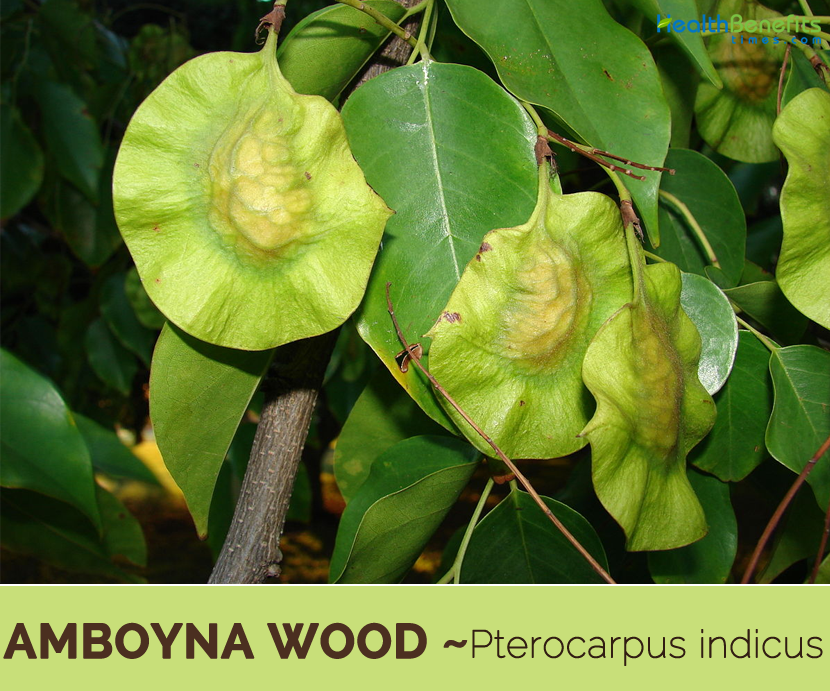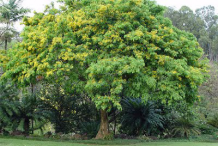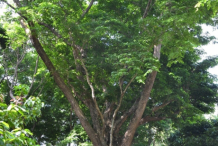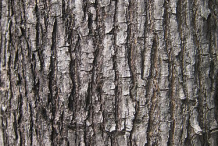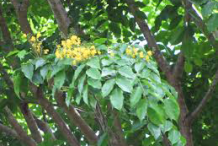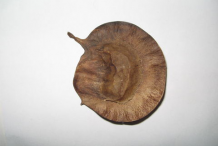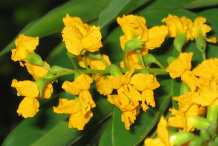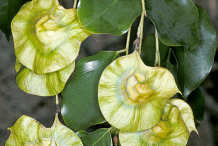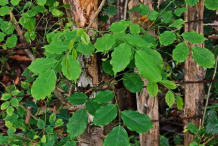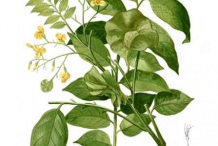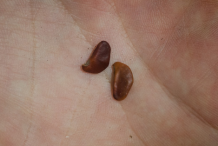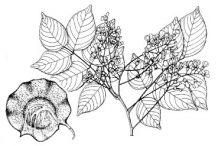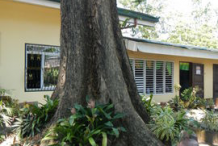Plant Description
Amboyna wood is a fast growing large, tall deciduous tree 30–40 m tall and 4 m wide with high buttresses, greyish bark and a trunk diameter up to 2 m. The plant is found growing in lowland primary and some secondary forest, mainly along tidal creeks and rocky shores. The plant is adaptable to a wide range of soil types including infertile, alkaline, stony soils to deep, fertile, loamy, alluvial soils. It is most commonly found growing in well-drained, sandy to clay loams of slightly acid to slightly alkaline. It often occurs near to the sea and probably has a moderate level of tolerance of foliar salt spray.
Leaves
The bright green, imparipinnate leaves are arranged alternately on the branchlets. Trees are either briefly fully deciduous or may be evergreen in uniformly humid zones. The new flush of leaves is light green, turning dark mid-green. Each leaf has (5–) 7–9 (–11) alternately arranged, ovate leaflets; each leaflet is about 6–12 cm (2.4–4.8 in) long by 3–7 cm (1.2–2.8 in) wide, with an entire margin. The terminal leaflet is larger, with the smallest leaflets in the lowest pair on the rachis.
Flowers
Flowering is often initiated before the new leaf flush but continues after leaf flushing. Flowering takes place in several short bursts of about 1–2 days duration. The pea-shaped flowers are bright yellow to orange-yellow, about 1.5 cm (0.6 in) long, fragrant, and arranged in branched axillary racemes. The flowers are borne in profusion, adding to the ornamental appeal of trees when in full flower. Seasonality of flowering varies geographically.
Fruit
Flowers are followed by pods that are thin, papery winged, disc-shaped, about 5–6 cm (2–2.4 in) across, and borne in clusters. They are light green, turning dull brown when fully mature. Pods consist of contains one or two seeds, and does not split open at maturity; it ripens within 4–6 years, and becomes purple when dry. Seeds are flattened, bean-shaped, 6–8 mm (0.2–0.3 in) long with a leathery, although rather brittle, seed coat. Pod/ seed dispersal is mainly by wind. Pods can float, and water dispersal is likely to also be significant for riverine populations.
History
Pterocarpus indicus is native to Southeast Asia, northern Australasia and the western Pacific Ocean islands. According to Rojo ( 1972 ) its western limit is southern Myanmar, extending eastward to peninsular Thailand, Malaysia, Laos, Kampuchea to Vietnam and Taiwan, farther eastward reaching the Solomons in the Pacific via Sumatra, West Java, Borneo, Philippines, Sunda Islands, the Moluccas, New Guinea and the Pacific.
Health benefits of Amboyna wood
Amboyna wood is important to people in many ways. As you may know that Amboyna leaves is one of immune booster to keep your body healthy. Amboyna leaves is already recognized as one of medicinal Plant in the world. It contains some nutrition which can prevent or fight certain diseases. The leaves are derived from timber trees is mainly famous as effective natural remedy for a variety of health problems. Listed below are some of the well-known health benefits of Amboyna wood
1. Prevent us from Cancer and Diabetes
Amboyna wood has been renowned as one of plant that can reduce blood sugars levels based on some researches from using animals. It sounds good if you want to control blood sugars levels and change your diet life, you can consume Amboyna wood’s leaves are boiled and brewed it like tea or coffee.
2. Relieves Pain in Menstrual Disorders
Amboyna wood’s leaf can also reduce pain when every woman gets through their daily periods. Some woman is having physical or emotional symptoms just before or after menstruation. From heavy bleeding and missed periods to unmanageable mood swings, these emotional syndromes may disturb a woman’s life in major ways.
3. Curing Thrush and Diarrhea
Thrush and Diarrhea are the most common reasons for people to seek medical advice. It affects every age so then it becomes a common health complaint. Curing those medical problems with Amboyna wood’s leaf potion is quite easy. You just cut the older bark of the leaf then boil it to the water to cure Thursh. While for diarrhea, add a little salt and then made a complaint mouthwash for canker sores and drink the potion
4. Overcoming Burn
Angsana leaf has flavonoid which can relieve pain which caused by burns. You can mash the leaf until smooth then boiled for 1 minute than cooling it immediately. After that, you can past the boiled leaf into the pain by burns slowly. It can also relieves the pain of burns then heal the skin to regeneration once again into new skin which was burned before.
5. Curing and Treat the Kidney Stones
Kidney stones can form in the kidney, in the tube draining urine from the kidney (the ureter) or in the bladder. They can be many different sizes and shapes. Most of them are unknowingly there with no reasons. Most stones are made of calcium while in other cases, the amount of calcium and other chemicals in the urine and blood is normal. If the level of these chemicals is high enough in the urine, they can form into stones. It can be one of alternative to treat Kidney Stones especially for those who choose traditional medicine. Just use the bark of the leaf as much as 3 grams then mix it with Keiji leaf and Cat Whisker leaf. After that, you boiled it with 115 ml of water. You can consume it on 110 ml in daily. Meanwhile, after drink it, usually the stone will come out in the form of crystals or urine.
6. Curing Fever
Benefits of Amboyna wood’s leaf is to cure and relieve fever disorder effectively. Fever which usually affect patients of all kinds of ages. You need to add the palm sugar or brown sugar into the juice leaf water which has been crushed or ground. With the sweetness of palm sugar or brown sugar, consume this herb in the middle of a high fever likely will not be a problem, especially in pediatric patients because palm sugar can reduce the bitter taste of leaf.
7. Anti – Aging for Skin Care
Fresh young Amboyna wood’s leaf is used for skin problems such as prickly heat rash, and sores, and they are also used most of cosmetic ingredients. It leaves are useful for fight against skin problems such as acne which become problem for every women especially teens. As you know acne is the common cause of spots. Most people with acne are aged between 12 and 25 but some older and younger people are affected. Therefore, using young leaf is one of alternative to reduce acne in your skin.
8. Known as Natural Immune Booster
Angsana leaf works more as a natural immune booster which boosts what your body naturally has. It is an amazing health supplement which matches and enhances body’s natural immune system for fight against illnesses. It targets whatever is unbalanced in the body. Angsana Leaf can also be food supplement that anyone can take it for help to prevent illnesses by boosting the immune system.
9. Effective Antioxidant
Angsana is known to be a very effective antioxidant, particularly a blood purifier. It is good for people with imbalance hormonal conditions and prostate problems. Angsana leave can also help those who want to lose weight and find back their balancing body.
10. Natural Hair Treatment
Angsana old leaf also can be used for hair care, particularly for getting it thicker than before. You just squeezing some leaf into bowl and the boiled it for a while. After that, wipe the boiled leaves on the scalp then wait until dry. Mix it with shampoo, wash and rinse them with hot water for the better treatment.
Traditional uses and benefits of Amboyna wood
- Kino is a well-known Malay medicine and is used commonly for treating sores especially oral sores.
- Kino or a Bark decoction is used for thrush and to arrest diarrhea in Java.
- Young leaves are applied to ripening boils, ulcers and prickly heat.
- Leaf infusion is used as hair wash.
- Juice from the roots is used for syphilitic sores.
- In folk medicine, it is used to combat tumors.
- Tree is used to treat throat ailments, mouth sores, mouth tumors, diarrhea, boils, prickly heat, ulcers, and syphilis.
- Young leaves applied to boils, prickly heat and ulcers.
- Decoction of wood used for dropsy and to dissolve bladder stones.
- Red latex used in folk medicine for tumors, cancers and warts.
- Juice of root applied to syphilitic sores.
- Malays used the resin for buccal sores.
- Decoction used as a gargle for sore throats; as an astringent; as a mouthwash for toothaches.
- It is used for tuberculosis, headaches, sores, and as purgative in Papau New guinea.
- It is used to treat dysentery, menorrhagia, and gonorrhea in Solomon Island.
- It is used for treat cuts and wounds, stomachache and diarrhea in infants in Vanuatu.
- Young leaves are used for boils, ulcers, and prickly heat rashes in Indonesia.
- Plant used as folk remedy for bladder ailments, diarrhea, dropsy, headache, stones, thrust, and tumors of the abdomen.
- Poultice of heated leaves applied to the abdomen for amenorrhea.
- Leaf decoction used to induce first menstruation after childbirth, at the same time, applying a poultice of heated leaves on the navel.
- Young stems of Pterocarpus indicus are chewed with young stems of C. equisetifolia to prevent conception in Vanuatu.
Ayurvedic Health benefits of Amboyna wood
- Skin Diseases: Crush the leaves of Indian Kino (Bijasal). Extract the juice and over infected skin. OR Apply the chopped leaves as a poultice on the affected area.
- Diabetes: Take half tsp Indian Kino tree (Bijasal) powder with lukewarm water once a day. It is easily available in market.
- Asthma: Take Ziziphus Xylopyrus roots, Sodom stem bark, Erythroxylum monogynum stem bark, Indian Kino stem bark and 10 dry Cayenne peppers. Grind them all to make a fine powder. Consume quarter tsp of each of the herb powder for 3 days with 1 liter of water once a day.
Other Facts
- It is the national tree of the Philippines as well as the provincial tree of Chonburi and Phuket in Thailand.
- indicus is widely planted as an avenue/roadside tree and as shade trees in car parks, gardens and parks in Southeast Asia.
- Flowers are a honey source.
- Reddish hard wood is an excellent timber and is listed among the most valuable timbers in the Philippines.
- It is used for cabinetry, cart wheels, carvings, construction, floorings and musical instruments, and when finely sliced, it produces an extremely decorative veneer, used for decoration and furniture.
- Tree also provides kino, a reddish dye narrin, resin and gum used for tanning.
- Amboyna is finely sliced to produce an extremely decorative veneer, used for decoration and in making of furniture and keys on a marimba.
- Leaves are supposedly good for waxing and polishing brass and copper.
- It is also a source of kino or resin.
- Infusion of the leaf used as shampoo.
- Seeds mature about 3–4 (–5) months after flowering.
Precautions
- Angsana wood is used as a folk remedy for stomach pains, sprue, palpitations of the heart, rheumatism, leucorrhoea, gravel and yaws.
- Burkill also reported that in Kampuchea, the wood is used for fevers and is considered as diuretic and anti-dysenteric.
- Red sap from its incision of the bark becomes a kind of red crystal after some hours of exposure to air, which is used as an astringent and against other diseases.
- According to Hartwell, the red latex is used in folk remedies for tumors, the plant for cancers, especially of the mouth.
- In the Carolyn Islands, finely powdered leaves are applied to a ruptured vagina.
References:
https://www.itis.gov/servlet/SingleRpt/SingleRpt?search_topic=TSN&search_value=506292#null
https://davesgarden.com/guides/pf/go/168942/
http://www.hear.org/pier/species/pterocarpus_indicus.htm
https://npgsweb.ars-grin.gov/gringlobal/taxonomydetail.aspx?id=30286
https://pfaf.org/user/Plant.aspx?LatinName=Pterocarpus+indicus
http://www.theplantlist.org/tpl/record/ild-1893
https://plants.usda.gov/core/profile?symbol=ptin2
https://en.wikipedia.org/wiki/Pterocarpus_indicus
http://www.worldagroforestry.org/treedb/AFTPDFS/Pterocarpus_indicus.PDF
https://www.cabi.org/isc/datasheet/45419
Comments
| Amboyna wood Quick Facts | |
|---|---|
| Name: | Amboyna wood |
| Scientific Name: | Pterocarpus indicus |
| Origin | Southeast Asia, northern Australasia and the western Pacific Ocean islands |
| Colors | Light green, turning dull brown when fully mature |
| Shapes | Pods that are thin, papery winged, disc-shaped, about 5–6 cm (2–2.4 in) across, and borne in clusters |
| Taste | Bitter, acrid, Astringent, sweet |
| Health benefits | Prevent us from Cancer and Diabetes, Natural Immune Booster, Curing Fever, Relieves Pain in Menstrual Disorders, Anti – Aging for Skin Care, Curing Thrush and Diarrhea, Overcoming Burn, Curing and Treat the Kidney Stones,Natural Hair Treatment |
| Name | Amboyna wood |
|---|---|
| Scientific Name | Pterocarpus indicus |
| Native | Southeast Asia, northern Australasia and the western Pacific Ocean islands |
| Common Names | Amboyna Wood, Andaman Redwood, Angsana, Beeswing Narra, Blanco’s Narra, Burmese Rosewood, Malay Paduak, Narra, New Guinea Rosewood, Pashu Padauk, Philippine Mahogany, Prickly Narra, Red Sandalwood, Redwood, Tenasserim Mahogany |
| Name in Other Languages | Bangladesh: padauk Brunei Darussalam: angsana Burmese: Padauk, Ansanah, Pashu-padauk Chinese : Zi Tan (紫檀), Qiángwēi mù (蔷薇木), Huáng bò mù (黄柏木), Qing long mu, Huang bai mu, Tzu tan English: Amboyna-wood, Andaman redwood, Burmese rosewood, Malay padauk, Papua New Guinea rosewood, Philippine-mahogany, Red Sandalwood, Sang Drago, Sang Dragon Fijian : Padouk Finnish: Manilanveripihkapuu French : Amboine, Santal Rouge Amboine, Pterocarpus indicus Germany: Rosenholz, Indisches; Sandelholz, Echtes Hindi: Narra, bijasal, vijayasar Indonesia : Angsana, Angsena, Chendan Merah, Lingod, Sena, Sonokembang Japanese : Yaeyama-Shitan Kampuchea : Tnug Kannada: Bethonne, Hanemara Laos : Chan Deng Malaysia : Angsana, Paduak, Pokok Sena, Sena Myanmar : Ansanah, Pashu-Paduak Palauan : Las Papau New Guinea : New Guinea Rosewood Philippines : Kamarag, Tagga, Tagka, Sagat, Vitali, Balauning, Sagat, Daitanag, Naga, Odiau, Bital, Agaña, Asana, Nara, Narra Samoa : Pinati Solomon Islands : Liki, Ligi, Nyia Neli, Na, Noi‘Eni, Ringi, Rigi, Dandara, Nakumu, Grigi, Riki Swedish : Amboinaträd Sanskrit: Pitasala Tamil: Narra, Vengai, Vangai Maram Telegu: Peddagi, Yerravegisa Thailand : Praduu Baan, Pradoo, Duu Baan, ประดู่บ้าน Vanuatu : Bluwota, Neniera, Nar, Narara, Nanara, Navilae, Navulae, Nula, Philae, Philai, Vulae, Vuvilae, Nakambis, Nusmar Weiwuli, Burmeia, Purmeia, Vohovati, Nakautufe, Kautufa, Kautora, Kautofa, Nakautefa Vietnam : Giáng Hương ấn; Giáng Hương Mắt Chim; Gióc; Huỳnh Bá Rừng Yapese : Arau |
| Plant Growth Habit | Fast growing large, tall deciduous tree |
| Growing Climates | Found in lowland primary and some secondary forest, mainly along tidal creeks and rocky shores |
| Soil | Adaptable to a wide range of soil types including infertile, alkaline, stony soils to deep, fertile, loamy, alluvial soils. It is most commonly found growing in well-drained, sandy to clay loams of slightly acid to slightly alkaline |
| Plant Size | 30–40 m tall and 4 m wide |
| Trunk | 2 m diameter |
| Leaf | Imparipinnate, 12–22 cm long, with 5–11 leaflets, rachis and petiolule glabrescent |
| Leaflets | Ovate-elliptic, 4–5 by 6–10 cm, chartaceous to subcoriaceous; surfaces concolorous and glabrous, lateral veins 6–8 pairs, margin entire, base rounded, obtuse to acute, apex acuminate |
| Flowering Periods | February to May |
| Flower | Flowers few to numerous. Bracteoles 2, linear-oblong, at base of calyx. Calyx campanulate, 5–6 mm long, deltoid lobes hairy inside towards the top. Corolla yellow, petals long clawed; standard ovate-orbicular to oblong, 16–18 mm; wings oblong, as long as standard; keel narrowly oblong, smaller than wings. |
| Fruit Shape & Size | Orbicular or semi-orbicular legume, brown to blackish, densely hairy, 4–6.6 cm across, shortly stalked and broadly winged around margin, wing to 2 cm wide. |
| Fruit Color | Light green, turning dull brown when fully mature |
| Seed | Reniform, narrow and oblique 2–5 by 8–10 mm, smooth and brownish. |
| Taste | Bitter, acrid, Astringent, sweet |
| Plant Parts Used | Heartwood, leaves, flowers, gum, steam bark |
| Propagation | Seed or large stem cuttings |
| Health Benefits |
|
| Culinary Uses |
|


